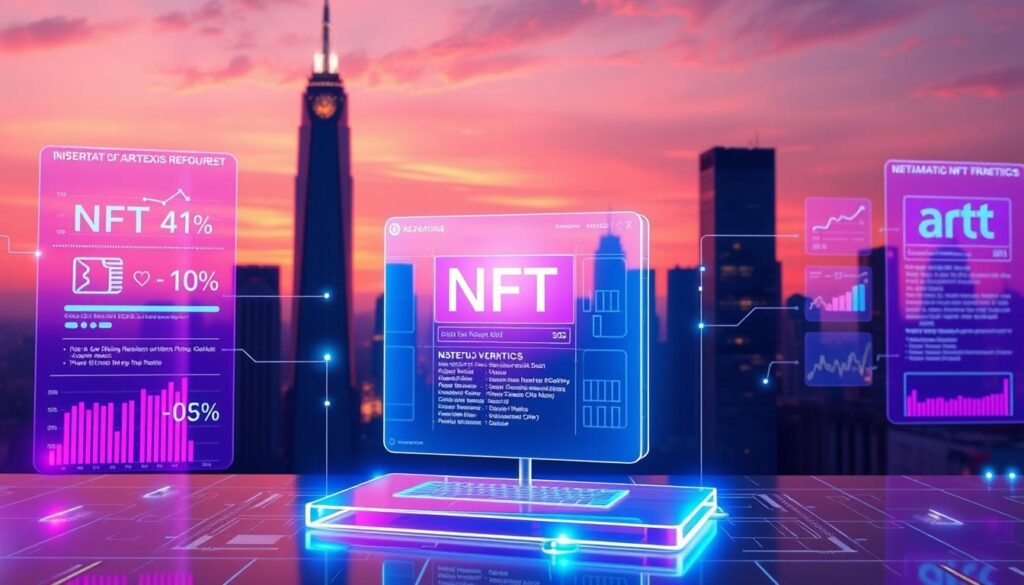Now Reading: Soulbound NFT Non Transferable Identity Verification Credentials
- 01
Soulbound NFT Non Transferable Identity Verification Credentials
Soulbound NFT Non Transferable Identity Verification Credentials

Imagine a world where your online achievements and affiliations stay permanently tied to you, like a digital fingerprint. This vision is becoming reality through innovative cryptographic tools that lock specific assets to individual users. Unlike typical collectibles that circulate freely, these specialized tokens serve as unbreakable proof of participation.
First proposed by Ethereum’s co-founder in 2022, this concept merges decentralized technology with personal reputation systems. By anchoring information to unique wallet addresses, it creates tamper-evident records of skills, memberships, and accomplishments. This approach solves critical challenges in verifying authenticity across virtual platforms.
The technology’s design prevents unauthorized transfers while maintaining transparency. Through self-executing contracts, users gain full control over their digital footprints. This breakthrough could transform how organizations issue certifications and how individuals manage professional portfolios.
Key Takeaways
- Specialized tokens create permanent links between users and their digital achievements
- Ethereum’s co-founder pioneered this approach for Web3 reputation systems
- Assets remain locked to original wallets through cryptographic protocols
- Decentralized networks enable secure verification of personal credentials
- Users maintain complete ownership of their virtual identity components
Introduction to Digital Identity and Blockchain Credentials
Digital identity management is in crisis, with personal information scattered like puzzle pieces across the web. For decades, organizations have stored sensitive data in centralized silos vulnerable to breaches and misuse. New decentralized approaches now challenge this status quo by empowering individuals to own and control their virtual presence.
Understanding the Shift in Digital Identity
Paper diplomas and plastic ID cards dominated credentialing for centuries. Digital certificates improved accessibility but inherited the same flaws – reliance on third-party validators and easy duplication. Current systems struggle with cross-platform recognition, forcing users to repeatedly prove their qualifications.
Centralized databases create single targets for hackers while limiting user oversight. A 2023 IBM report revealed 83% of companies experienced multiple data breaches tied to identity vulnerabilities. This systemic fragility highlights the urgent need for self-managed solutions.
The Role of Blockchain in Securing Credentials
Distributed ledger technology introduces unalterable record-keeping through cryptographic seals. Unlike traditional methods, these systems enable instant confirmation of authenticity without middlemen. Users can selectively share verified achievements while maintaining privacy.
This approach builds trust through transparency – anyone can audit verification processes without accessing sensitive details. Educational institutions and employers already pilot these methods to streamline hiring and reduce credential fraud by 67% according to recent industry trials.
Concept of Soulbound NFTs in the Digital Era
The digital revolution continues to reshape how we establish ownership and authenticity. A new type of cryptographic asset challenges traditional notions of tradable value by creating unbreakable bonds between users and their virtual accomplishments.
Defining Permanent Digital Markers
These specialized assets act as immutable proof of participation, unlike conventional collectibles. While standard tokens circulate freely, this innovation anchors achievements directly to users through self-executing code that resists duplication or transfer.
Core Features That Redefine Ownership
Three key traits distinguish this approach:
- Irreversible links to original creators/owners
- Smart contract restrictions preventing resale
- Transparent verification across platforms
This system transforms qualifications into permanent components of one’s digital footprint. Educational certificates or professional licenses become tamper-proof badges that evolve with their holders.
| Feature | Traditional NFTs | New Model |
|---|---|---|
| Transferability | Allowed | Disabled |
| Ownership Proof | Collectible Value | Personal History |
| Primary Use Case | Art/Memorabilia | Reputation Systems |
By merging decentralized networks with personal achievement tracking, this model lays groundwork for more trustworthy online interactions. Organizations can now issue verifiable records that remain tethered to recipients’ virtual profiles.
soulbound NFT non transferable identity verification blockchain credentials
The digital landscape now confronts a pivotal question: What happens when virtual ownership becomes inseparable from personal achievement? This shift introduces cryptographic assets that refuse to follow conventional market rules. While typical collectibles circulate freely, a new breed of digital assets creates permanent user-specific connections through code-driven restrictions.

What Sets Them Apart from Traditional NFTs
Standard fungible tokens serve as tradeable proof of ownership, but their value stems from exchangeability. The latest innovation modifies this dynamic through three core technical differences:
- Code-enforced binding to original owners
- Disabled secondary market transactions
- Time-based metadata updates
These traits transform how platforms recognize qualifications. Academic institutions could issue time-limited certifications that automatically expire, while preserving achievement records permanently tied to graduates.
| Feature | Conventional Model | New Framework |
|---|---|---|
| Market Dynamics | High liquidity | Fixed ownership |
| Data Flexibility | Static metadata | Programmable traits |
| Fraud Resistance | Transferable proof | Earned validation |
This structure prevents credential purchases while enabling evolving identity profiles. Like a driver’s license gaining endorsements through renewed testing, these assets reflect growth without losing foundational authenticity.
Benefits and Use Cases of Soulbound Tokens in Various Sectors
Modern credential systems are undergoing a silent revolution. Specialized digital markers now enable institutions to issue tamper-proof records that travel with individuals throughout their careers. This innovation particularly shines in sectors requiring reliable validation of qualifications.

Credentials & Achievements in Education and Professional Fields
Universities could replace paper diplomas with sbts that automatically appear in graduates’ digital wallets. Employers would instantly confirm degrees without contacting registrars. A 2024 pilot program showed this method reduces verification time by 89% compared to traditional processes.
Professional fields benefit through portable skill records. Healthcare organizations now test sbts for tracking continuing education credits. These tokens update automatically when workers complete new certifications, creating living career profiles.
- Instant validation of academic transcripts
- Self-updating professional licenses
- Fraud-resistant training certificates
The technology also addresses resume inflation. A recent survey found 78% of hiring managers encountered falsified credentials last year. Permanent digital records tied to verified achievements could eliminate this $3 billion annual problem.
Micro-credentials represent another breakthrough. Vocational programs can issue sbts for specific competencies like advanced welding techniques or AI programming skills. This granular approach helps candidates showcase niche expertise that traditional degrees might overlook.
The Role of Verification and Reputation in Digital Identity
Online trust faces unprecedented challenges as digital interactions multiply. Traditional systems allow users to fake qualifications or create duplicate profiles, undermining trustworthiness across platforms. New cryptographic tools now anchor personal achievements to unique identifiers, creating self-managed proof of authenticity.

Building Trust and Combating Fraud
Fraudulent activities cost businesses $4.2 billion annually, often through fake accounts or stolen credentials. Permanent digital markers solve this by linking achievements directly to users through innovative credential systems. This prevents Sybil attacks – where malicious actors create multiple identities – by making each profile as unique as a fingerprint.
Three critical improvements emerge:
- Automated validation of qualifications through decentralized networks
- Immutable records of professional endorsements
- Cross-platform recognition of earned reputation
Social media platforms using this approach report 72% fewer fake profiles. Voting systems in decentralized organizations now require verified participation histories, ensuring fair decision-making. Unlike traditional methods, revoked certifications leave permanent trails – creating accountability at every career stage.
These systems enable smarter trust algorithms that analyze verified skills rather than self-reported claims. Recruitment platforms using this data achieve 41% better candidate matches according to recent trials. As evolving credential approaches gain traction, they reshape how we establish credibility in virtual spaces.
How to Create and Implement Soulbound NFTs
Building secure digital credentials requires careful technical planning and platform selection. Developers must balance network capabilities with long-term sustainability while ensuring core features remain intact.

Selecting the Appropriate Blockchain Platform
Ethereum remains the primary choice for deploying specialized tokens, but alternatives like Polygon offer lower transaction fees. Key considerations include:
- Gas costs for frequent credential updates
- Developer tool availability
- Existing infrastructure for SBTs
| Platform | Transaction Cost | Developer Community | Active SBT Projects |
|---|---|---|---|
| Ethereum | High | Extensive | 380+ |
| Polygon | Low | Growing | 120+ |
| BNB Chain | Medium | Moderate | 45+ |
Modifying Smart Contracts for Non-transferability
Developers typically start with ERC-721 standards, then disable transfer functions in Solidity code. Essential modifications include:
- Overriding _transfer() with revert statements
- Implementing owner-based minting
- Adding metadata update controls
Security audits become critical when altering core contract logic. Leading firms like OpenZeppelin recommend multi-signature approval for credential revocation systems. Proper testing ensures tokens maintain their permanent association while allowing necessary updates.
Tools and Platforms for Developing Soulbound NFTs
Building trustworthy digital systems requires specialized development tools designed for permanent asset creation. Leading platforms streamline the process while maintaining strict security standards. Three solutions stand out for crafting unremovable digital markers.
OpenZeppelin’s Trusted Framework
This platform provides pre-audited contract templates with built-in restrictions. Developers can access code libraries that disable asset transfers while allowing metadata updates. Its modular system supports custom rules for issuing and revoking credentials.
Thirdweb’s Accessible Toolkit
This developer-friendly platform simplifies complex processes through visual interfaces. Ready-made SDKs handle token deployment across multiple networks. Built-in features support time-based access controls and permission systems.
Manifold’s Customization Power
Focused on advanced use cases, this solution enables granular control over asset behavior. Creators can implement unique logic for credential expiration or achievement stacking. Its API integration supports real-world verification workflows.
Deployment tools like Hardhat and Truffle ensure smooth testing across environments. These utilities help developers simulate network conditions and audit security measures. Combined with robust platforms, they form a complete ecosystem for building tamper-proof digital records.
FAQ
How do blockchain-based credentials improve security compared to traditional systems?
Blockchain’s decentralized structure eliminates single points of failure, reducing hacking risks. Data encryption and immutable records ensure credentials like academic degrees or work certifications can’t be altered, enhancing trust in platforms like Ethereum or Polygon.
Why are non-transferable assets valuable for reputation management?
Unlike fungible tokens, these assets are tied to a specific wallet, preventing unauthorized transfers. This creates a tamper-proof record of achievements, skills, or affiliations—ideal for LinkedIn-style professional profiles or university transcripts.
Can these tokens integrate with existing platforms like OpenZeppelin?
Yes. Tools such as OpenZeppelin’s library allow developers to customize smart contracts for non-transferability. Thirdweb and Manifold also offer templates to streamline creation while ensuring compliance with privacy standards like GDPR.
What industries benefit most from this technology?
Education institutions can issue unforgeable diplomas. Healthcare systems might manage licenses securely. Gaming platforms like Axie Infinity could reward unique achievements, while decentralized finance (DeFi) protocols might assess user trustworthiness for loans.
How does proof-of-ownership work without transferring assets?
Ownership is verified via cryptographic signatures linked to a user’s wallet. Publicly accessible ledgers confirm authenticity without exposing personal data, balancing transparency with privacy—a key feature in platforms like Civic or Microsoft’s ION.
Are there risks of centralization with these systems?
While some platforms use permissioned blockchains, open-source frameworks like Hyperledger promote decentralization. Smart contract audits by firms like CertiK further ensure systems remain tamper-resistant and aligned with Web3 principles.
Can users revoke access if credentials are compromised?
Yes. Revocation mechanisms can be coded into smart contracts. For example, if a certificate is invalidated, issuers like universities or employers can update the ledger, automatically reflecting changes across all connected platforms.














